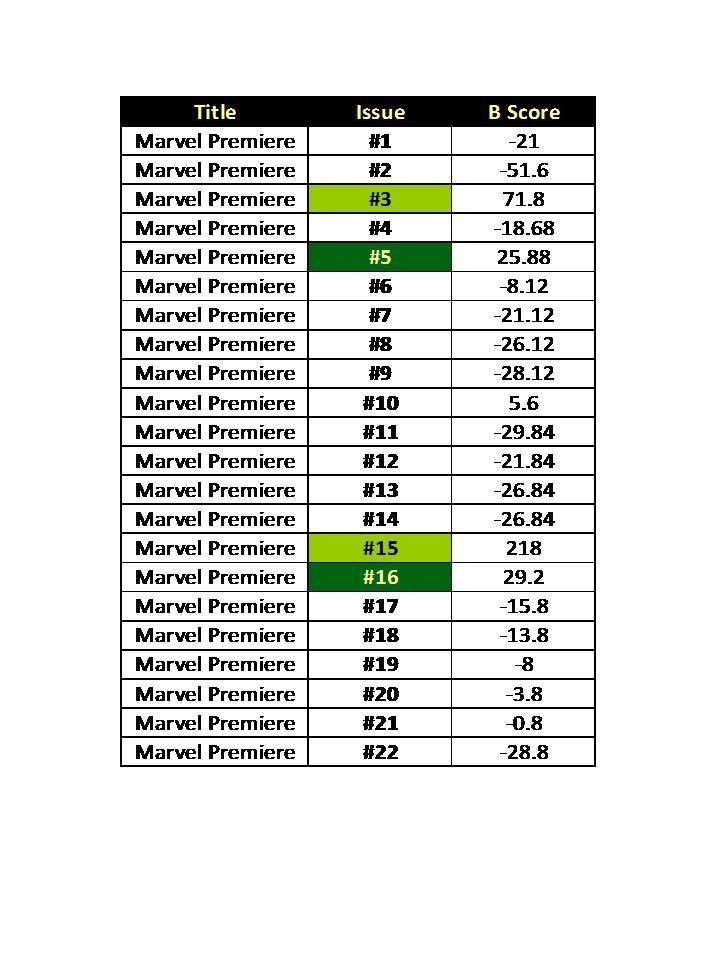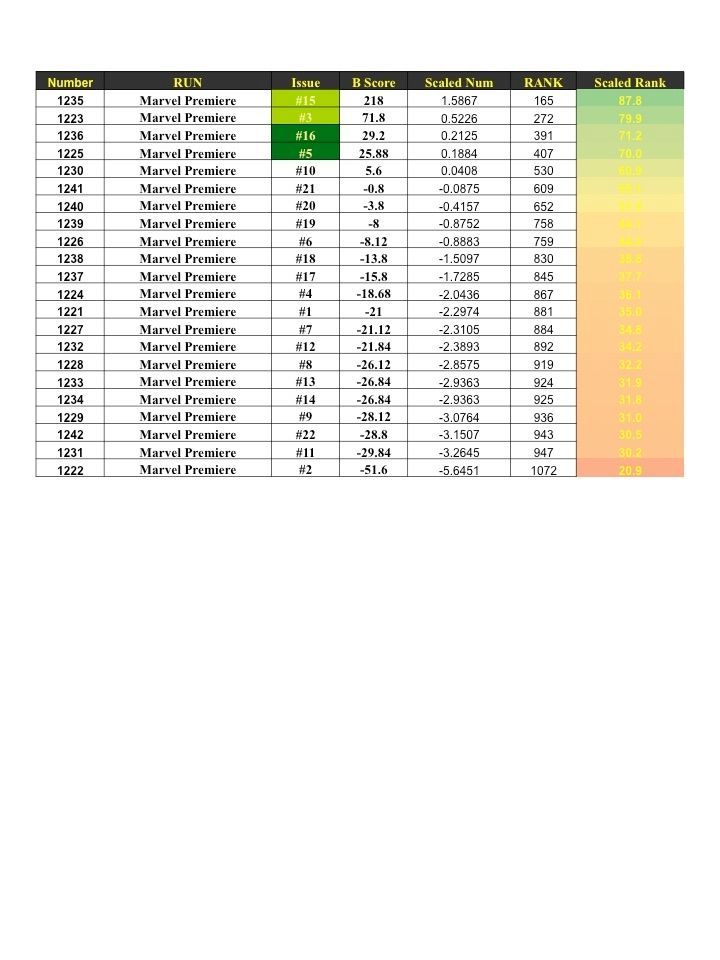Investment Potential and Analysis of Marvel Premiere Issue 1 to 22
Investment Potential and Analysis of Marvel Premiere Issue 1 to 22
The first Table
presents the Bias Score for all the issues. Bias scores show
which issues are being bought by the Insiders (Pros) vs. the Outsiders (Fans
Less Serious). The concept of my approach is to focus on the issues being
bought BULLISHLY by the investors.
We developed an
analysis of data to quantify this Bias (B Score). We mark the
issues with the highest Bias with Lime Green followed by a Dark Green staining
for issues with a lesser but definite Bias.
This Run has Warlock for the First 2 issues, Dr Strange from Issue 3 to 14 and then the star of this run, Iron Fist at Issue 15 on to 25.
The highest B Score Issue is Issue 3 the first Doc Strange with a score of 72, Issue 5 has a score of 26, the star issue and first Iron Fist with a B Score of 218 and Issue 16 the second Iron Fist with a B Score of 29.2
Only Issues 3 and 15 are targeted because these issues have the top B Scores while 5 and 16 are lesser prospects.
Table 1. B Score of Marvel Premiere Issue 1 to 22

Table 2 data
deals with another data stream on comic-book issues. This run’s issues are
looked at 3 grades 9.4, 8 and 6. The changes in bias between the different
grades are calculated and the SLN
numbers were born. The SLN numbers
look into each “world” of the I vs.
O bias data. This data has shown historically
to be the most liberal and establishes the investment potential across the
grades of 9.4, 8 and 6. Very quickly, the green stained are positive issues and
red stained issues are a negative and invite a non-focus in only investments
We then compare
those SLN numbers and generate a
difference number we call the DF. Finally add the I and O SLN
numbers together (total) and determine the %DF number for each issue. Green
staining is good (Higher Bias) and Grey and Red are issues that are not good
for an investment focus. This data stream is more liberal in the rigor and you
get the best case for an issue,
This data stream continues to highlight issue 3 on to 21 as targets.
Table 2. SLN,DF, and %DF of Marvel Premiere Issue 1 to 2

The deepest level
of analysis we developed is the ADF number (average
difference between the I/O worlds) of each issue at each grade. I denote a high
I Bias with the orange $.
Lime green
stained issues are rated I Biased in all grades or at least 9.4 and 8. Dark
green stained issues are only biased at the 9.4 grade while the other grades
are overbought relative to the professional investor’s desires.
Table 3 is the
stricter data stream and highlights both the issue and grade. We calculate the
average difference (ADF) in Issue Bias between the Insider and Outsiders
groups. Lime Green are issues that are I Biased at least 9.4 and 8 grades
(High Bias). (Orange $). The dark green issues are support with a Bias in 9.4
grade only. The other issues are to be avoided.
Investment-wise, Issue 1 shows up because when you tease out the overbought data from grade 6, its Bias at the 9.4 and 8 is shown! Issue 15 is highlighted as a target at all grades including 6. Issue 3 is to be targeted at 9.4 only
Table 3. ADFs of Marvel Premiere Issue 1 to 22

Table 4 is the
Score Card information for each issue at the 3 data streams. This allows a top
down view across the data streams. We denote the issues supported in all three
data streams with a Lime Green staining. Dark Green has only 2 data streams
support and yellow issues are supported in one data stream only.
The same issues of 3, 5 15 and 16 are highlighted
Table 4. Score Card of Marvel Premiere Issue 1 to 22

Table 5 is the
last bit of data, the Scaled
Desire Ranking. I have grouped 1356 issues of comics that I have covered
and developed scaled desire rankings. The percentile that an issue occupies
gets wonderful insight into true value between titles. So we position our title
and its key issues in context. A score
of 99 means that comic issue is desired at the highest level while 1 percentile
is the lowest desired issue.
Note that Issue 15 in by itself at the 87 percentile. followed by issue 3 at 80 percentile. Issues 16 and 5 are desired at the 70th percentile level.
Table 5. Scaled Desire Ranks of Marvel Premiere Issue 1 to 22


Comments
Post a Comment